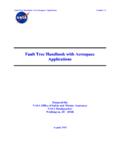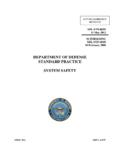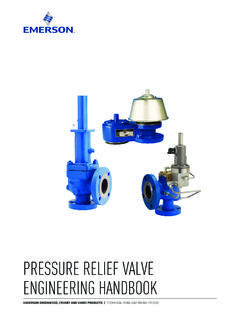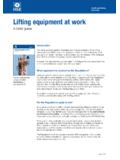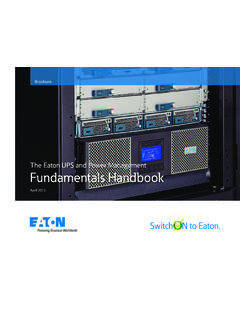Transcription of An Introduction to Computer Security: The NIST …
1 National Institute of Standards and Technology Technology Administration Department of Commerce An Introduction to Computer security : The NIST Handbook Special Publication 800-12. Assurance User Contingency Planning I&A. Issues Personnel Training Access Risk Crypto Controls Audit Planning Management Support Program Physical Policy Threats & Management security Operations Table of Contents I. Introduction AND OVERVIEW. Chapter 1. Introduction . Purpose .. 3. Intended Audience .. 3. Organization .. 4. Important Terminology .. 5. Legal Foundation for Federal Computer security Programs . 7. Chapter 2. ELEMENTS OF Computer security . Computer security Supports the Mission of the Organization. 9. Computer security is an Integral Element of Sound Management.
2 10. Computer security Should Be Cost-Effective.. 11. Computer security Responsibilities and Accountability Should Be Made Explicit.. 12. Systems Owners Have security Responsibilities Outside Their Own Organizations.. 12. Computer security Requires a Comprehensive and Integrated Approach.. 13. Computer security Should Be Periodically Reassessed.. 13. Computer security is Constrained by Societal Factors.. 14. Chapter 3. ROLES AND RESPONSIBILITIES. iii Senior Management .. 16. Computer security Management .. 16. Program and Functional Managers/Application Owners .. 16. Technology Providers .. 16. Supporting Functions .. 18. Users .. 20. Chapter 4. COMMON THREATS: A BRIEF OVERVIEW. Errors and Omissions .. 22. Fraud and Theft.
3 23. Employee Sabotage .. 24. Loss of Physical and Infrastructure Support .. 24. Malicious Hackers .. 24. Industrial Espionage .. 26. Malicious Code .. 27. Foreign Government Espionage .. 27. Threats to Personal Privacy .. 28. II. MANAGEMENT CONTROLS. Chapter 5. Computer security POLICY. Program Policy .. 35. Issue-Specific Policy .. 37. system -Specific Policy .. 40. Interdependencies .. 42. Cost Considerations .. 43. Chapter 6. Computer security PROGRAM MANAGEMENT. iv Structure of a Computer security Program .. 45. Central Computer security Programs .. 47. Elements of an Effective Central Computer security Program 51. system -Level Computer security Programs .. 53. Elements of Effective system -Level Programs.
4 53. Central and system -Level Program Interactions .. 56. Interdependencies .. 56. Cost Considerations .. 56. Chapter 7. Computer security RISK MANAGEMENT. Risk Assessment .. 59. Risk Mitigation .. 63. Uncertainty Analysis .. 67. Interdependencies .. 68. Cost Considerations .. 68. Chapter 8. security AND PLANNING. IN THE Computer system LIFE CYCLE. Computer security Act Issues for Federal Systems .. 71. Benefits of Integrating security in the Computer system Life Cycle .. 72. Overview of the Computer system Life Cycle .. 73. v security Activities in the Computer system Life Cycle .. 74. Interdependencies .. 86. Cost Considerations .. 86. Chapter 9. ASSURANCE. Accreditation and Assurance .. 90. Planning and Assurance.
5 92. Design and Implementation Assurance .. 92. Operational Assurance .. 96. Interdependencies .. 101. Cost Considerations .. 101. III. OPERATIONAL CONTROLS. Chapter 10. PERSONNEL/USER ISSUES. Staffing .. 107. User Administration .. 110. Contractor Access Considerations .. 116. Public Access Considerations .. 116. Interdependencies .. 117. Cost Considerations .. 117. Chapter 11. PREPARING FOR CONTINGENCIES AND DISASTERS. Step 1: Identifying the Mission- or Business-Critical Functions120. vi Step 2: Identifying the Resources That Support Critical Functions .. 120. Step 3: Anticipating Potential Contingencies or Disasters .. 122. Step 4: Selecting Contingency Planning Strategies .. 123. Step 5: Implementing the Contingency Strategies.
6 126. Step 6: Testing and Revising .. 128. Interdependencies .. 129. Cost Considerations .. 129. Chapter 12. Computer security INCIDENT HANDLING. Benefits of an Incident Handling Capability .. 134. Characteristics of a Successful Incident Handling Capability 137. Technical Support for Incident Handling .. 139. Interdependencies .. 140. Cost Considerations .. 141. Chapter 13. AWARENESS, TRAINING, AND EDUCATION. Behavior .. 143. Accountability .. 144. Awareness .. 144. Training .. 146. Education .. 147. Implementation .. 148. Interdependencies .. 152. Cost Considerations .. 152. vii Chapter 14. security CONSIDERATIONS. IN. Computer SUPPORT AND OPERATIONS. User Support .. 156. Software Support .. 157. Configuration Management.
7 157. Backups .. 158. Media Controls .. 158. Documentation .. 161. Maintenance .. 161. Interdependencies .. 162. Cost Considerations .. 163. Chapter 15. PHYSICAL AND ENVIRONMENTAL security . Physical Access Controls .. 166. Fire Safety Factors .. 168. Failure of Supporting Utilities .. 170. Structural Collapse .. 170. Plumbing Leaks .. 171. Interception of Data .. 171. Mobile and Portable Systems .. 172. Approach to Implementation .. 172. Interdependencies .. 174. Cost Considerations .. 174. viii IV. TECHNICAL CONTROLS. Chapter 16. IDENTIFICATION AND AUTHENTICATION. I&A Based on Something the User Knows .. 180. I&A Based on Something the User Possesses .. 182. I&A Based on Something the User Is .. 186. Implementing I&A Systems.
8 187. Interdependencies .. 189. Cost Considerations .. 189. Chapter 17. LOGICAL ACCESS CONTROL. Access Criteria .. 194. Policy: The Impetus for Access Controls .. 197. Technical Implementation Mechanisms .. 198. Administration of Access Controls .. 204. Coordinating Access Controls .. 206. Interdependencies .. 206. Cost Considerations .. 207. Chapter 18. AUDIT TRAILS. Benefits and Objectives .. 211. Audit Trails and Logs .. 214. Implementation Issues .. 217. Interdependencies .. 220. Cost Considerations .. 221. ix Chapter 19. CRYPTOGRAPHY. Basic Cryptographic Technologies .. 223. Uses of Cryptography .. 226. Implementation Issues .. 230. Interdependencies .. 233. Cost Considerations .. 234. V. EXAMPLE. Chapter 20.
9 ASSESSING AND MITIGATING THE RISKS. TO A HYPOTHETICAL Computer system . Initiating the Risk Assessment .. 241. HGA's Computer system .. 242. Threats to HGA's Assets .. 245. Current security Measures .. 248. Vulnerabilities Reported by the Risk Assessment Team .. 257. Recommendations for Mitigating the Identified Vulnerabilities 261. Summary .. 266. Cross Reference and General Index .. 269. x Acknowledgments NIST would like to thank the many people who assisted with the development of this handbook. For their initial recommendation that NIST produce a handbook, we thank the members of the Computer system security and Privacy Advisory Board, in particular, Robert Courtney, Jr. NIST management officials who supported this effort include: James Burrows, F.
10 Lynn McNulty, Stuart Katzke, Irene Gilbert, and Dennis Steinauer. In addition, special thanks is due those contractors who helped craft the handbook, prepare drafts, teach classes, and review material: Daniel F. Sterne of Trusted Information Systems (TIS, Glenwood, Maryland) served as Project Manager for Trusted Information Systems on this project. In addition, many TIS employees contributed to the handbook, including: David M. Balenson, Martha A. Branstad, Lisa M. Jaworski, Theodore Lee, Charles P. Pfleeger, Sharon P. Osuna, Diann K. Vechery, Kenneth M. Walker, and Thomas J. Winkler-Parenty. Additional drafters of handbook chapters include: Lawrence Bassham III (NIST), Robert V. Jacobson, International security Technology, Inc.
